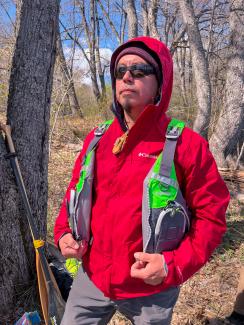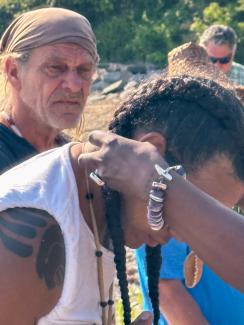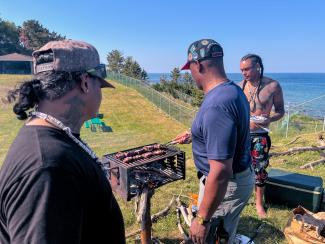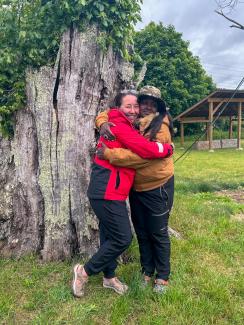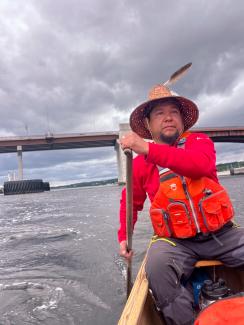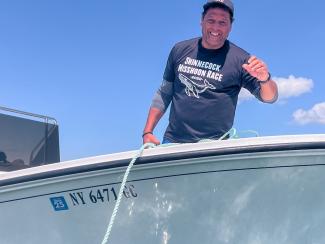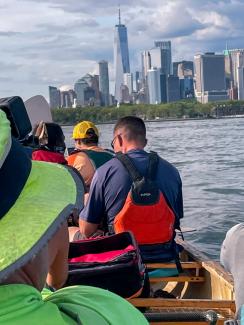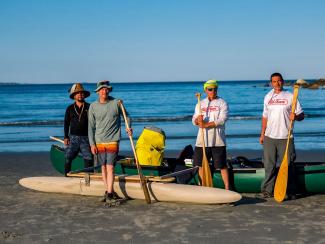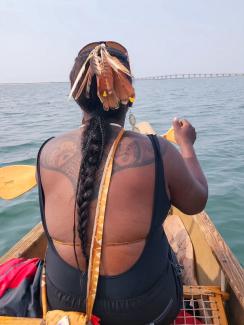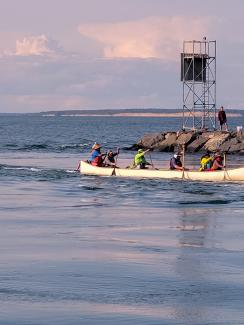Over the years we have come to recognize and accept many types of intelligence, including logical-mathematical intelligence, linguistic intelligence, interpersonal intelligence, intrapersonal intelligence, musical intelligence, spatial intelligence, kinesthetic intelligence, and naturalist intelligence. In recent years, emotional intelligence has not only gained more traction, it has become an industry. We have even gone beyond the traditional terms of intelligence by exploring Artificial Intelligence, and now Generative Artificial Intelligence. This article is not just about one type of intelligence, but a universal intelligence that encompasses all others: cultural intelligence. Specifically, it is about the cultural intelligence of the Canoe People, who were one of the first people to travel by water.
Cultural intelligence refers to the ability to relate and work effectively in culturally diverse situations. It’s the capacity to cross boundaries and successfully navigate multiple cultures that go beyond our existing knowledge of cultural sensitivity and awareness. An individual possessing cultural intelligence is not just aware of different cultures; they can culturally adapt and effectively work and relate with people across a variety of cultural contexts.
Since 1,200-year-old and 3,000-year-old Native American canoes have been found in Lake Mendota, Wisconsin, believed to have been built by Ho-Chunk Peoples, it is important to connect the dots of history and the impact that Canoe People had, and continue to have. Canoes were, and are, the most common type of traditional Native American boat, used throughout much of North America, Central America, the Caribbean, and many parts of South America. The word canoe comes from the Carib Indian word, kenu.
Many of the historic canoes are referred to as “dugouts” and are considered to be the earliest form of human-made water vessels. A dugout canoe, or dugout, is a boat made from a hollowed-out tree. Other names for this type of boat are logboat and monoxylon, which are constructed from large basswood, cottonwood soft maple tree trunks, and other types of trees to be used by travelers and adventurers to paddle.
May 9 - 30
For a typical adventurer, paddling from one location to another might not require cultural intelligence. However, a historical route paddled by the descendants who are Aboriginal to the route requires it. Being a Tribal citizen of the Shinnecock Nation, navigating through waterways today requires experience on the water, an understanding of maritime law, and strong relationships with Tribes throughout the route. It also requires knowledge of the historical background and respect for the cultural sites along the route and proper cultural protocol in the canoe and on land. With this level of cultural intelligence, we cannot only have safe passage, but can travel similarly to our ancestors.
The laws today and the way that the waterways are utilized in modern times make navigating the waters far more challenging than what my ancestors would have experienced. The use of motorboats, overdevelopment along the waterways, bottom trolling of the seafloor, and the constant pollution of the waterways, make waters more treacherous today than they were before the settlement of colonists. Particularly in the Northeast, these factors make paddling in canoes in the open ocean dangerous in the eyes of many. Nearly 500 years ago, our waters were as calm as the energy of our ancestors. The shoreline birds were unthreatened because they could nest without the intrusion of development. Wakes in the tidal water were only caused by nature and not massive ships. The marine life was not under constant threat, so the stress levels of all life in the ocean were almost non-existent.
In May 2023, I embarked on a canoe journey from Boston Harbor to the Long Island Sound. Our journey was in recognition of the sovereign rights of the Tribal people who still reside in their traditional homelands. The first stop on the route I navigated was Nickerson Beach in the Boston Harbor—traditional homelands of the Ponkapaog Peoples. With permission from their Tribal leaders, we were able to camp and hold a sunrise ceremony before the launch of the canoe. We landed the canoe and camped in areas that hadn’t been accessible to Tribes because of land theft over the years.
The experience of taking a traditional canoe route with relatives who are spiritually and historically connected to the route was life-changing. For years I have studied the historical waterways and traditional routes through oral history passed down to me while paddling in many of the waterways to learn the water, spending as much time as possible paddling throughout the historical route. Over the last four years I have been holding Indigenous perspective paddle tours in Conscience Point, Long Island, New York. Last year, on one of my last tours of the season, one participant, Freddie Wilkerson, took a particularly strong interest in the revitalization of canoe culture. He would later ask me to be a guide for a small crew that included Tribal people from Penobscot, Onondaga, and Oneida Nations, and I realized that I was about to officially embark on something that I had been preparing for nearly my entire life.
June 1-2
When people first think of a journey like this, they generally focus on the fact that their body has to be in shape. Fortunately, I had paddled across the Long Island Sound once before and have paddled for years on canoe journeys with various people from our sister Tribes, so the focus of my preparation was on the cultural protocol and logistics for the journey. Freddie invited all of the crew members to take a two-day water rescue training on the Kedsig River in Bangor, Maine. We all traded stories of our water experiences, and while most of the crew had more river and lake experience than I did, I had more ocean experience. It was a true trade in knowledge and the start of the excitement to embark on a 1,500-mile paddle throughout Maine to the Atlantic Ocean, throughout the Northeastern seaboard, into the Hudson River in New York City, north toward Canada, and back south to Maine. The crew called it the “Great Canoe Loop.”
On May 7, the Penobscot cultural bearers prepared a traditional sendoff for Freddie, Neil Bennett, and Ryan Ranco Kelly, who were from Penobscot Territory in what is known as Old Town Maine. Along the way, they were guided by other experienced Northeastern Native American canoe guides. Hickory Edwards (Onondaga), who has well over 15 years of paddling on the Hudson River into the Atlantic Ocean, joined the crew in Portland, Maine.
I joined the crew of four paddlers in the Boston Harbor, where we were also greeted by a few of the Tribes in Massachusetts. A crucial part of the journey was the support we received during our preparation and throughout the journey. Steve Anderson, who has been a longtime friend to the Shinnecock Peoples and has been traveling in northwest Tribal canoe journeys, helped with the grounds crew, charting the route, and paddling. Mashpee Wampanoag water carrier Jodi Newcomb led the crew in a sunrise ceremony when the tribes of the New England region joined the journey. We were sent off by many of the Tribal people of Massachusetts with traditional foods, gifts, songs, and prayers.
Picking up sister Tribal people along the way, we paddled and portaged the canoe from the ocean over to the Taunton River. We paddled through and camped in the homelands of sister Tribes and prepared our meals each night with food sourced from our Tribal communities like moose meat, fiddleheads, cod cakes, pickled leeks, smoked salmon, blueberry slump, sassafras tea, and maple syrup. During our visits we exchanged stories about ancestors that were interrelated to the Tribes throughout the region. Each place that we camped was historically known in our Tribal communities as places from which to launch canoes. The waterways are what have connected our Tribes, and it is through using these waterways that we can maintain our connections.
All of the Tribes in Long Island began working together to coordinate stops. As we traveled throughout our sister Tribal communities in New England, word was spreading that we were getting closer. We received much encouragement and excitement from friends and family. Relatives from our sister Tribes took days off of work to help be our grounds crew, helping us launch land and secure camp throughout our stay in New England.
June 4 - 9
On June 8 we crossed the Long Island Sound from Weekapaug Beach, Rhode Island at 8:30 a.m. at slack tide. Three Shinnecock men prepared a support boat to come all the way from Shinnecock territory to Watch Hill, Rhode Island to support our paddle across the Long Island Sound. The air quality was terrible due to the wildfires in Canada. I was gifted six bandanas, onto which I rubbed cedar oil and encouraged each paddler to wear one in place of a mask so the cedar could assist with breathing.
The islands throughout the Long Island Sound were not as visible as usual due to the air being so thick with smoke, so I relied on my Traditional Knowledge of understanding how the land and water came to be. We paddled in the route that kept us away from any ferry and boat traffic. We bypassed what is known as Plum gut, where riptide, especially near Plum Island, is significant even on a calm day. Beneath the turbulent waters lies a sharp reef that attracts baitfish and predators. This area is what Elders have always told me to avoid. Paddling on the other side of Plum Island might appear to be a longer route on the map, but it is a faster and safer route according to the water patterns. After 33 miles of paddling, we were greeted by our Cuchaog relatives who graciously hosted us in Orient, New York.
On June 9, we prepared ourselves for an important paddle through the Shinnecock Canal. The Tribe prepared a water and tobacco ceremony as we were to paddle through this historic canoe route. There is a rich history in this canal that led to the importance of the water and tobacco ceremony. In 1556, Monotucksee sachem (chief) of the Montaukett people in Long Island and several surrounding Long Island tribes dug a safe passage for mishoons (canoes) to go from one side of Long Island to the other. This is known today as the “Shinnecock Canal.”
Before the massive inlet in the Shinnecock Bay was created, there were freshwater ponds and brackish waterways. The colonists capitalized off of the intelligence of the Aboriginal Peoples of these waterways and created ports and harbors from one side of the island to the other, eventually taking control of the canal and stealing the land around it. The east end of Long Island is surrounded by the ocean; gaining safe passage in the water from one side of Long Island to the other is still a fight we face today as we exercise our rights to paddle through.
During this trip we paddled through the routes our ancestors have always taken to get from the ocean to the bays and into the Long Island Sound. However, due to an unfortunate event, we were swamped by a massive yacht that had zigzagged in a no-wake zone. As we paddled from Orient that morning, the water was so calm. Shinnecock relatives were gathering to see us come through the canal. The support boat was still with us and was in communication with all who were on the ground to update them on our ETA. As we approached the canal I could see the Shinnecock flag being held by our Tribal Chairman, and standing next to him to help were Elders and drummers, who were singing.
As we continued to paddle through, I could hear the crowd of people cheering and shouting for us. It was historic to have Canoe People come through one of the oldest canoe routes in the area. I was overwhelmed by the number of Tribal members who came out to witness and experience this historic moment. I heard the women singing a Shinnecock song that translates to “Together we move forward.” Sitting in the front of the canoe, I kept my eyes on the water and could see the strong current. Although the water was calm, we still needed to stay in sync and focus on getting through the canal.
June 10 - 19
I looked ahead and saw a massive yacht directly in front of us blowing its horn. We were unable to move because there had been walls built on both sides of what my ancestors had dug out. So, we had to focus on staying in unison and keeping the canoe straight. As the boat became closer, it picked up speed and started creating wakes. I could see that it was going to take a lot of strength to maneuver through them. At this point we were only about five miles from our destination and had paddled over 18 miles. I shouted, “KEEP PADDLING! PADDLE, PADDLE, PADDLE!” As I was in the first seat, I took the first few splashes straight in the face. Once we were side by side with the boat I could see the extent of wake it was creating and all I could think of was that I had to surf the wave and get enough speed to help the entire canoe surf.
As we encountered the first swell, reality hit us that we were in a severely dangerous situation. Although I could not see everyone's face, I could feel that we were completely in sync, paddling as strong as we could as a crew. After surfing the first wave we dropped and water dumped into our canoe, but we were still afloat. There was no time to bail out water, only to prepare for the next wave to surf. I didn’t take my eyes off the waves. I could tell the waves were not natural but man made, so it was hard to find the rhythm. After the third wave we had taken on so much water that the canoe was officially swamped and the water pushed the canoe under water completely. At that moment I felt water rush over my legs and everything that was in the canoe began to flood. Within a few seconds we no longer had the ability to paddle. We just floated in our life vests.
My strongest memory is the sound of the foam from the water in my ears. We each confirmed that no one was injured and immediately flipped the canoe upside to stabilize it and keep it from sinking. I made my way over to the support boat and my uncle grabbed my hand and pulled me up onto the boat. Once I was standing on that boat I could see that all of our items were scattered throughout the canoe and the current had pulled our things under or into Shinnecock Bay. After we each got onto the support boat, Neil remained with the canoe until we could get out into the Bay for the support boat to tow it to where we could flip it right side up. Once we all were aboard the support boat and the canoe was bailed out, there was a moment we could breathe and realize we had just survived an obstruction of our religious rights, as we had been in the middle of a water and tobacco ceremony. All of the sacred items we had in the bow of the canoe were lost at sea, if not in the bottom of the Shinnecock Canal. The only sacred item that survived was the bundle I had been carrying since I joined the crew in Boston.
Although we were fully soaked and our support boat crew had also been tossed around, we all felt it important to finish the paddle to Shinnecock territory. The timing of tides had changed because it was much later than anticipated, so we faced high winds and strong currents as we paddled closer to the inlet in the Shinnecock Bay. We were cold because we had not been able to dry off or get to land. When we arrived at Shinnecock we were greeted by more than half of the Tribe. We landed the canoe in an area where we could hold water long enough for each paddler to introduce ourselves and ask permission to come ashore to share their culture with our tribe. When we got to shore, many people were there with blankets to wrap us. Tribal members were coming up to us with tears because they had just witnessed what had happened to us. The Tribe started a beach fire so we could gather around to get warm. They sang a friendship song and we danced around the fire. I had never seen such a beautiful canoe landing in all of my years of paddling. The entire community came out to help in whatever way needed.
Each stop holds a memory, but the events that took place for us to land on Shinnecock will forever be embedded in my memory because we survived that tragic incident. Shinnecock Canal history will forever include this historic event. From Penobscot territory to the Boston Harbor, we were greeted and hosted by so many Tribal communities. The unity was historic. A special thanks to Freddie for his vision of bringing Tribal people from the entire region together. We exchanged a lot of cultural knowledge about our canoe cultures in each of our communities, and we experienced a lot as a crew that brought healing to our communities.
June 20 - Aug 29
A special thanks also to the following Tribes for opening up their homelands and hosting us and providing shelter, food, and resources as we traveled through: Ponkapaog, Mattakesett, Massachusett, Wampanoag, Pokanoet, Seekonk, Niantic, Narragansett, Cuchaog, Shinnecock, Unkechaug, and Montaukett.
I would also like to thank the following institutions for recognizing the cultural significance of this journey and ensuring our safety by supporting us while we were on the water or camping on land: Thompson Island, Fourth Cliff Air Force Base, New York State Office of Parks, Recreation and Historic Preservation - Long Island Region, and the U.S. Coast Guard.
In addition to the Tribal communities who greeted and hosted us along our journey, we were also greeted by many of our other relatives, including deer, foxes, birds, snakes, dolphins, seals, whales, and fish. The spiritual experience of mutual communication gave me the confidence that I was not only accepted but that they were expecting me. Even the plants felt like they understood my journey as they provided shelter, comfort, and nourishment.
This type of cultural experience is both ancient and rare, particularly for a woman. While you have to have cultural history, knowledge, and understanding of your route, there is nothing that can replace the experience and educational gifts received from actually paddling those waters. Even the water itself has a story to tell if you are willing to listen since it is alive and has participated in everything that has ever happened on planet Earth. To listen to and understand what the water is telling you about the history and the future is one element of the cultural intelligence of Canoe People; however, the two-way communication between myself and the water while paddling gave me a higher understanding of cultural intelligence.
The canoes come from trees, which grew as a result of nourishment distributed to the roots by way of water. Therefore, trees and water are families to each other. When you put a canoe in the water, you are reuniting family members to once again receive the time-honored nourishment of growth and development. And when you are paddling that canoe on the water, you become part of the giving and receiving of that nourishment. It is at that time that your intelligence of the culture of Canoe People is enlightened.
—Chenae Bullock is an enrolled Shinnecock Indian Nation Tribal member and descendant of the Montauk Tribe in Long Island, New York. She is a community leader, water protector, cultural preservationist, Indigenous perspective historian, and humanitarian. She is also the founder and CEO of Moskehtu Consulting, LLC, and a 2022-2023 Cultural Survival Writer in Residence.



